Promoting a small business through social media can now be considered one of the essential tools for success. A fundamental tenet that came out of the dot com bubble, social media, and the internet is a viable marketing tools.
Businesses began creating profiles on existing social media sites, realizing the positive effects. As the years passed, attitudes toward the medium changed, along with marketing preferences for business.
In the modern era, 90% of executives consider social media for small business as part of their overall brand focus. Online forms of interaction have permeated corporate branding, customer care, lead generation, and e-commerce.
Marketing expenses have dropped considerably, social for small business, and customer satisfaction rates have risen across the board. Products are getting to market quicker because customer feedback has risen due to social sites like Twitter.
Customers now expect the brands they buy from to have a social media presence. 58% of customers have said they are more likely to purchase from a company they follow on social media.
Small Business Social Media: Where to Start?
Businesses no longer have one or two social media platforms to deal with. There are dozens of social media platforms, and each channel is used differently. Each platform offers different but precise results. Social media can make any business successful and engaging or waste an excessive amount of time.
Find your audience:
Hopefully, you started your business with a roadmap to success, and social media should be no different. Without a solid plan in place, there is no means to measure success. Take the time up front to establish a social media plan that fits your overall long term business objectives.
- Create specific social media goals that are measurable, relevant, and attainable. Base your goals on what impact social media channels will have on your business goals, like improving a conversion rate or attracting a specific client type.
- Audit your social media accounts that you have now and evaluate your efforts. Use this audit checklist.
- Find out what your competition is doing with their social media efforts; this will reduce your learning curve. Ask the question, how to do social media for small businesses. Try to determine similarities and differences in the message. Pay close attention to the colors and graphics being used.
- Look for inspiration from other businesses and industries. Only look for successful businesses and try to emulate their efforts. Again, study layouts, colors, and graphics of each site; what appeals to you and what does not.
- Creating a social media calendar early is your planning stage. How to do social media for small business, will get you off on the right foot and help with planning content. A social media calendar also helps. As an example, 80% content with 20 % going to promoting the brand. Here is an example of a social media content calendar:
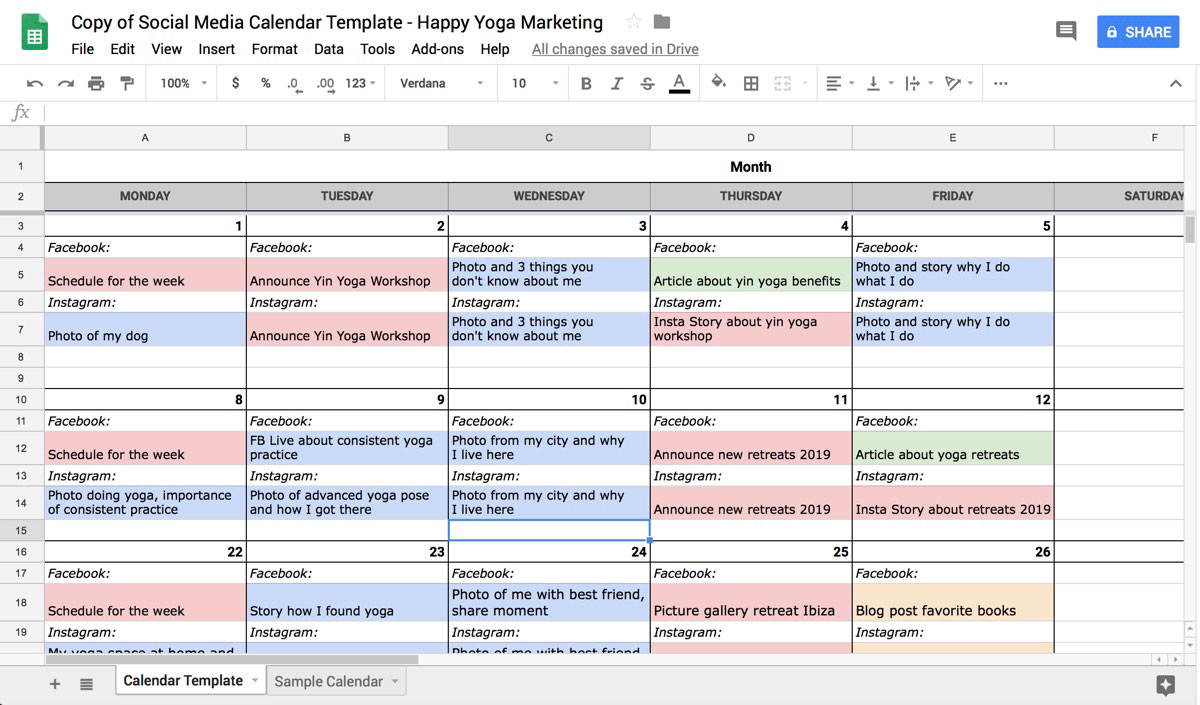
(Image Credit: Susanne Rieker)
Social media for small business owners can target groups of customers or one large audience. Before your business can begin with its social media plans, you should have a reliable picture of your audience.
- Dig as deep to find every characteristic essential to your business. Use keywords to uncover desirable traits. Uncover other interests to paint a complete profile of your ideal buying customer.
After a precise customer type has been established, head back to your plans, and find ways to expand your ideal customer. When you target new markets and products, you have a good idea of who your ideal customer is already. This shortens development time.
Focus on Quality
From the outset, use quality tools and platforms. This extra due diligence shows up in your finished product and any social for small business processes.
86% of consumers buy and follow the brands they feel are the most authentic, according to a survey from Stackla. Most experts agree it is vital to have quality content and interaction on a few social media channels, rather than a presence on all of them.
- Post great content on the channels you choose and offer value.
- Be human and honest. If all you want to do is pitch a product and sell, you give customers no incentive to visit your website.
- Once you have a couple of channels mastered with good content, move on, and open new social media accounts.
Test your website’s SEO and social media score in 60 seconds!
Diib is one of the best SEO and social media monitoring tools in the world. Diib syncs to Facebook and Google Analytics and uses the power of big data to help you quickly and easily increase your social media traffic and SEO rankings.
- Easy-to-use automated social media + SEO tool
- Keyword and backlink monitoring + ideas
- Speed, security, + Core Vitals tracking
- Automated ideas to improve Social Media traffic + sales
- Over 500,000 global members
- Built-in benchmarking and competitor analysis
Used by over 500k companies and organizations:
Syncs with 
The number of tools available for social media for small business owners can be overwhelming. However, you only need to slice off manageable pieces and master them, then move on.
Social media tools for the savvy marketer can simplify and automate much of the work. With the right mix of tools, a one-person office can appear to be a full corporate marketing team. One of the best overall SEO and social media programs on the internet is Google Analytics.
- Analytics: nothing is more critical than the tracking and reporting of your channels. Several companies have been in the business for years and recently moved into the reporting side. Hootsuite Insights is a comprehensive suite of products, from scheduling to reporting. For example:
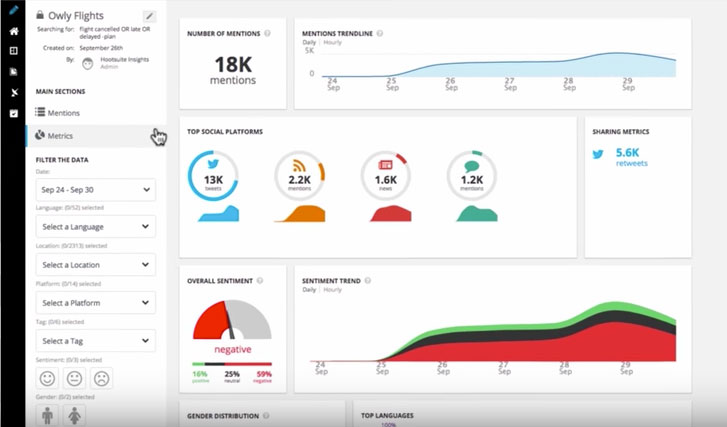
You Might Also Like
(Image Credit: GetApp)
- Engagement management is a program that takes all of your inbounds and social media accounts and presents them in a dashboard. With centralized management, modern marketers can manage a host of accounts and inbounds much easier.
- Content curation has always been a struggle for most webmasters. Keeping customers engaged and offering new content with every post is difficult. Tools such as BuzzSumo and Pocket can help curate exciting new content.
Tips to Market a Social Media Account
Use the following tips and insights to help with getting a page or plan up and running.
- Cohesiveness: Give users a cohesive visual experience and a means for running social media for small business. It is one thing to have a lot of accounts generating page views. It is another having the same number of views with half the social media accounts. For example, you have a visually appealing Facebook ad, and then users click through to an awful, disjointed landing page.
Aim for a cohesive quality message throughout every aspect of your social media plan. From the tab above, “Focus on Quality” from the outset. Landing pages are an excellent source of lead generation tools. However, If not handled correctly, a landing page is notorious for taking in leads and never seeing them again.
- Utilize Technology: Many social media platforms are countering landing pages with the technology of their own. As an example, Facebook has a Call button that can be placed anywhere on the ad. Press the button and call the office. Landing pages should have the same visual style as all your connected ads.
- Structure: The importance of planning an account structure can not be underestimated. Structure your social media campaigns around business objectives. The eagerness to open an account or begin a campaign has webmasters missing the big picture.
- Hands-on Approach: Remember, a cohesive and visually “in tune experience” throughout each social media channel. Make sure you are monitoring performance and results closely. The set-it-and-forget-it approach to social media advertising is terrible in the modern era. Everything happens too quickly for hands-off advertising. As tweets and posts age, they become much less effective. The longer you wait to refresh ad copy, the lower your ROI. Fresher ads garner better engagement rates.
- Use Twitter as a content development tool: Most webmasters use Twitter as a promotional tool. How to use social media for your small business, webmasters can tap into the vast network to access content availability or viable subject matter.
- Use Twitter to Gauge Effectiveness: Use Twitter to gauge the effectiveness of a topic or the content itself. Find out how well received a piece of content will be accepted. Read this post and see how Twitter Analytics can help your business.
As an example, a user tweets an infographic and then uses Twitter Analytics to evaluate the tweet’s performance. Use another piece of content and see how that content performs under scrutiny. For instance:
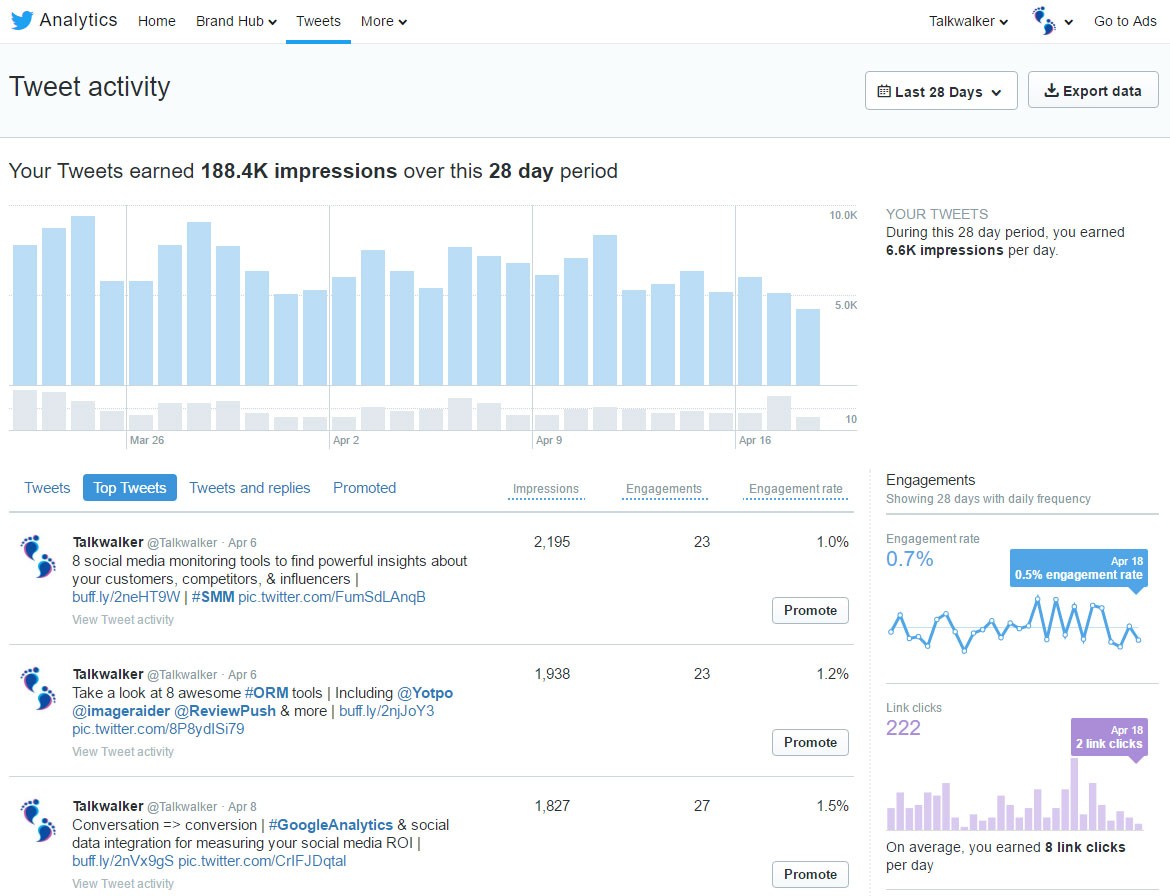
(Image Credit: Talkwalker)
- Narrow Focus: Narrow your targeting focus to boost engagement and reduce costs. Focus on increasing your engagement score from tweets. The lower your engagement score, the higher you pay for advertising.
The only way to improve your score is to narrow your focus to achieve higher rates with your tweets.
- Increase Your Targeting: Do not be too granular in finding your perfect social media audience. When finding out how to use social media for your small business, most platforms have become incredibly specific. Increase targeting parameters to gain more customers. Facebook and Twitter are leading the way in their ability to drill down to a particular type of consumer.
Target too broadly, and your engagement rates go down, too specific, and you risk a detrimental impact on your campaign.
- Balance: As a webmaster/ social media manager, you need to find a balance or happy medium.
- Start Layering: Start layering your targeting options to drill down even further into your perfect social media audience. Layering is a useful technique when finding a specific group.
Marketers can already target specific buyers by way of age, household income, education level, and so on.
Layering starts by adding additional factors on top, such as Facebook users between 30 and 40. Layer on top of that content, say a master’s degree. Keep layering until the perfect audience is found.
Choose Your Social Media Channels
Several retailers have found, running social media for small businesses is not an easy task. There are different social media platforms for different purposes, with new platforms popping up every month. Once you have found your ideal customer and the right path for your social media, channel selection should be natural.
Open an account on the platforms that seem to offer the most benefit for your small business. Post a few stories or promotions and see if there is any reaction. Continue to post on a regular schedule for a few weeks, gauge your feedback.
Five social media channels tower over the rest. Each channel gives specific value and the foundation for running social media for small business. Each channel gives webmasters a slightly different means of connecting with their audience.
The granddaddy of social media, Facebook, began operations in 2004 and features a massive user base. Facebook has 1 billion daily and 2 billion active monthly users. The channel has a sophisticated advertising setup.
Good ad spots and times at Facebook advertising does not come cheap for the single person office. However, if you want to drill down to your exact customer, Facebook is the place to go.
It may be advantageous for the one-person office to start a month or two and find their customer on Facebook. Then branch out and have that connection as a foundation.
If you are “Liked” on Facebook, customers want updates on your company and products. Your First Priority online is to
- Work these contacts
- Connect with them
- Build Relationships

(Image Credit: Econsultancy)
Your goals are to engage with as many people as the budget allows. Try different types of content, email messages, alerts, and so on. See what resonates well. Once you have found what works, stick with it, and expand.
FACT: There are over 80 million small businesses using Facebook’s free business tools. (HubSpot)
The channel has been around since 2002, making it one of the oldest social media channels. Once Microsoft bought LinkedIn, prospects, and outlook spiked, decidedly north.
The channel has moved to a business and prospect format. People want to connect with other professionals in their sphere of influence. Video does very well on LinkedIn. For instance:
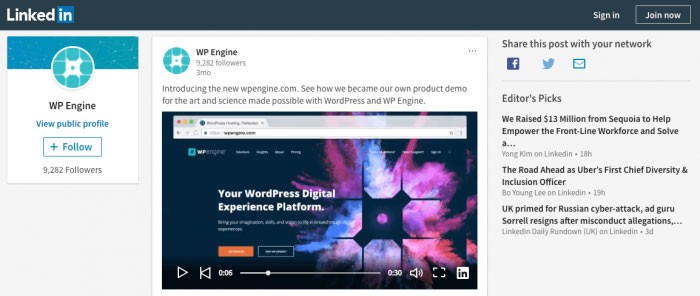
(Image Credit: Bannersnack Blog)
Post on the channel at least once a week. Try not to overshare on LinkedIn. Most members take the highbrow approach to spamming with email and SMS.
If your company has employees, utilize this resource. Have managers form small employee groups, get company favored content out in the marketplace. Remember, LinkedIn has a professional atmosphere; members want to keep it that way.
Share only the best parts of your business or product, and “Outstanding employee” video content seems to do well.
FACT: As of April 2020, LinkedIn’s number of users in the U.S. reached 160 million, making it the country with the most users in the world. (HubSpot)
We hope that you found this article useful.
If you want to know more interesting about your site health, get personal recommendations and alerts, scan your website by Diib. It only takes 60 seconds.
Twitter is another massive representation of the world’s population. Twitter is a fast-paced channel, where 500 million tweets are sent each day. 320 million active individuals and brands interact with each other daily.
Moving the character limit to 280 was a good move for the channel. It gave businesses more room for promotions and other content. Remember, Twitter has a substantial international base of users.
When posting a Twitter message, consider this, there are nearly 6,000 tweets per second sent on the platform. Multiple tweets during the day and at advantageous times is essential.
Look for times when your “type of customer” is getting off work or just getting home. Product promotions are a good choice for specific daily time slots. At times, Be playful in your message. Always add value to the content.
Keep any of your business communication bright and to the point.
FACTS: The number of global daily active users on Twitter is 166 million. In fact, Twitter is among the top three social channels used by marketers with the highest ROI. (HubSpot)
Instagram and YouTube
If there is any way to put your message or product on video, Do It Now. The growth of video sharing is quickly taking over any other medium. YouTube is the second-fastest-growing website on the internet, behind only Google.
It is all about the visuals when dealing with these two platforms. With Facebook owning Instagram, you place ad orders within the Facebook dashboard. Here is where you choose a written story format, video storytelling, or a combination of both. For example:
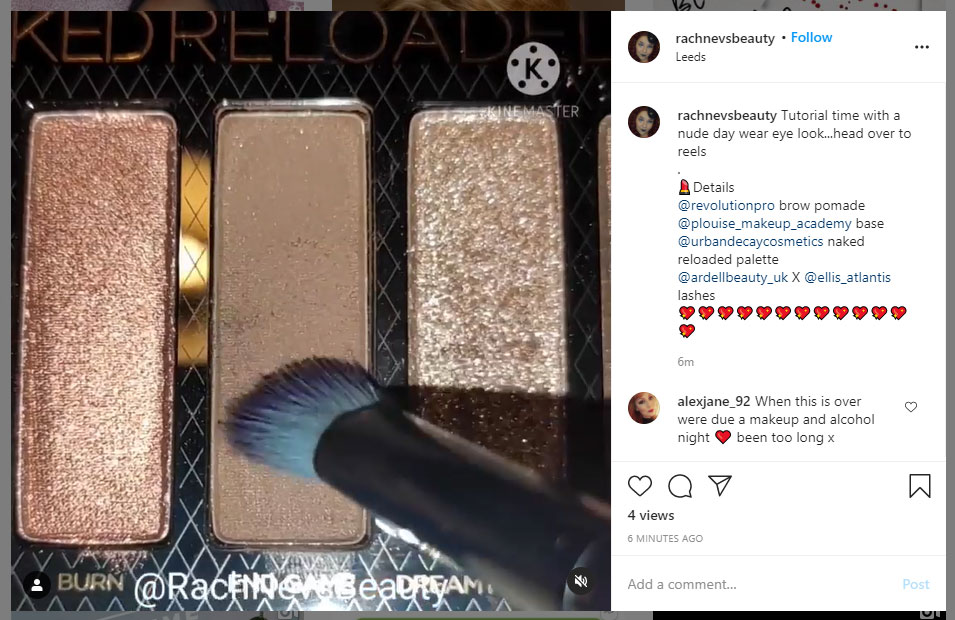
Video is different storytelling, but highly effective. Go to any brand’s website, and there are always a lot of short clips backing up corporate claims.
Posting quality and the number of posts per week does not change. However, video adds a whole new chapter of getting to the customer. The advantages of posting to these two platforms, a video presentation can add instant credibility to your brand.
Combined, nearly two billion people are active on YouTube and Instagram. If your product lends itself to a How-To format, that is the most popular theme on YouTube. Other themes you might not have considered, do well with video.
Make sure to tag videos correctly. With so much content continually uploaded, make it easy for your customers to find you.
FACT: In 2018, there were 3.7 million brand-sponsored influencer posts on the social platform. (HubSpot)
Final Thoughts
There are dozens of quality video and written content platforms available to the webmaster. Each having its form of displaying aggregated content. It is essential to investigate each platform thoroughly.
Find the platforms that closely match the theme of your website. How easy is it to share on your preferred platforms? Are there any restrictions that limit your ability to get your message out?
Move into new formats, even if you do not have the experience. Video, for example, is the hottest new medium on the planet. Consumers want to interact with brands and individuals they trust. The video puts your best face forward and allows webmasters to connect directly with their customers.
Diib®: Enhance Your Small Business’ Social Media!
Social media can be a boon to small businesses. Any accounts you open must be worked on a daily or weekly basis. If webmasters ignore the benefits of social media, they are ignoring their customers. Consumers look to social media for advice and help to choose the right brands and products. Partnering with Diib Digital can get your social media posts and ads in front of potential customers. Here are some of the features of our User Dashboard you’re sure to appreciate:
- Social media integration, engagement and performance
- Platform specific audience demographics
- Keyword, backlink, and indexing monitoring and tracking tools
- User experience and mobile speed optimization
- Technical SEO monitoring
Click here for your free scan or simply call 800-303-3510 to speak to one of our growth experts
FAQ’s
Marketing a small business on social media can seem confusing. Here are some proven methods to help:
- Create profiles on various platforms
- Have a clear, defined marketing plan
- Post content daily
- Give people reasons to follow you
- Use social media influencers
- Dabble with automation tools
- Encourage user generated content
We’ve talked about all of these platforms in this blog, however, here are the top 5 sites in order of popularity.
- Instagram.
- YouTube.
- Facebook.
- Twitter.
- TikTok.
Most studies advise posting once per day. One study even found that with pages under 10,000 fans, posting more than once per day resulted in a 50% drop in engagement. Minimally, we suggest posting 3 times per week.
There are so many great ideas for social media content. Here are our favorites: 1) Videos, both live and pre-recorded. 2) Post about your employees. 3) Relevant company news and market data. 4) Blog posts and industry articles. 5) Contests and giveaways.



